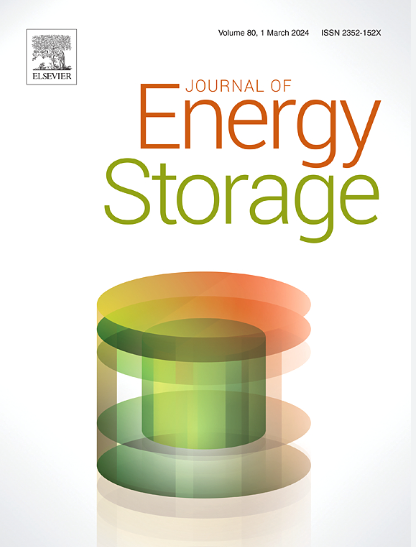Development and characterization of Ca(OH)₂ doped with expanded graphite for thermochemical energy storage: Integrating thermal conductivity, kinetics, and cyclic performance
IF 8.9
2区 工程技术
Q1 ENERGY & FUELS
引用次数: 0
Abstract
In light of the widespread adoption of novel energy sources, there is a pressing need for the rapid development of long-term energy storage technologies. While most existing energy storage technologies are prohibitively expensive, the thermochemical energy storage (TCES) system based on CaO/Ca(OH)₂ offers a high storage density of 1400 kJ/kg, low costs, and excellent cycle stability. The choice of expanded graphite (EG) as the matrix is based on its outstanding thermal conductivity and rich microstructure, which enhance heat and mass transfer. This study focuses on the thermochemical properties of Ca(OH)₂ doped by expanded graphite with stable morphology. Five samples with EG contents were synthesized, and characterized with regard to their microstructures, and their thermal and physical properties examined. Additionally, a reaction kinetic analysis of the thermal decomposition process was conducted. The results indicate that the composite with 9 % EG content stands out as the optimal thermal storage material, exhibiting a thermal conductivity of 2.5 W/(m·K), almost three times that of pure material. The activation energy of the composite was calculated to be 166.9 kJ/mol and the pre-exponential factor is 5.5 × 1011 1/s which is two orders of magnitude higher than the pure. Furthermore, the composite demonstrated exceptional stability during cyclic performance tests, maintaining a conversion rate of 70 % after 10 cycles, confirming its reliability. In conclusion, this research presents a novel approach for the large-scale, low-cost application of TCES in CaO/Ca(OH)₂ systems.
用于热化学储能的膨胀石墨掺杂Ca(OH) 2的开发和表征:集成导热性,动力学和循环性能
随着新能源的广泛应用,迫切需要长期储能技术的快速发展。虽然大多数现有的储能技术都非常昂贵,但基于CaO/Ca(OH) 2的热化学储能(TCES)系统具有1400 kJ/kg的高存储密度、低成本和出色的循环稳定性。选择膨胀石墨(EG)作为基体是基于其出色的导热性和丰富的微观结构,可以增强传热和传质。研究了形貌稳定的膨胀石墨掺杂Ca(OH) 2的热化学性质。合成了5种含EG的样品,对其微观结构进行了表征,并对其热性能和物理性能进行了测试。并对其热分解过程进行了反应动力学分析。结果表明,含9% EG的复合材料是最佳的储热材料,其导热系数为2.5 W/(m·K),几乎是纯材料的3倍。经计算,该复合材料的活化能为166.9 kJ/mol,指前因子为5.5 × 1011.1 /s,比纯品提高了两个数量级。此外,该复合材料在循环性能测试中表现出优异的稳定性,在10次循环后保持70%的转化率,证实了其可靠性。总之,本研究为TCES在CaO/Ca(OH)₂体系中的大规模、低成本应用提供了一条新途径。
本文章由计算机程序翻译,如有差异,请以英文原文为准。
求助全文
约1分钟内获得全文
求助全文
来源期刊

Journal of energy storage
Energy-Renewable Energy, Sustainability and the Environment
CiteScore
11.80
自引率
24.50%
发文量
2262
审稿时长
69 days
期刊介绍:
Journal of energy storage focusses on all aspects of energy storage, in particular systems integration, electric grid integration, modelling and analysis, novel energy storage technologies, sizing and management strategies, business models for operation of storage systems and energy storage developments worldwide.
 求助内容:
求助内容: 应助结果提醒方式:
应助结果提醒方式:


